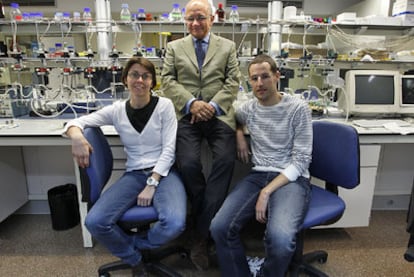A quick guide to cheating anti-doping controls
A University of Valencia scientific team alerts authorities when new scams emerge
It was physiologists' fascination for testing first on animals and then on humans how increasing the amount of oxygen the blood can transport augments physical performance that led to the great qualitative transformation of doping in the 1980s. In the 21st century, with the authorities showing legitimate concern that a succession of scandals is evidence of a spiral without beginning or end, anti-doping also took its qualitative step, similarly guided by the curiosity of physiologists and other scientists.
Some such scientists work in Valencia, at the Faculty of Medicine of the city's eponymous university, and recently they have provided the anti-doping bodies with an avalanche of studies published in industry journals that detail the myriad ways in which athletes can cheat the system.
"We do this because we need financing for our investigations"
"We did it to alert the authorities, so that they could take appropriate measures," says Fabián Sanchís-Gomar, acutely aware of the fine line that the group's studies are carried out on; they can equally be considered as an alarm bell or as publicity for fraudulent methods. "When the World Anti-Doping Agency (WADA) prohibits a substance, as it has done with AICAR [a performance enhancing drug], it makes the product known and piques the interest of athletes..." argues Sanchís-Gomar.
One example involves the anti-doping community's most expensive and sophisticated weapon, the biological passport, which is designed to detect the manipulations of cyclists and has given rise to a never-ending debate in legal and scientific circles. As it is based on the principle that, if there are external stimulants through EPO or transfusions that increase hemoglobin but reduce the percentage of reticulocytes (young red blood cells) - the signs noted in the passport - cheats fall back on smaller doses of EPO combined with hypoxia sessions by means of a machine that is not prohibited and that simulates the scarcity of oxygen at altitude, which in turn stimulates reticulocytes.
"We have demonstrated it on rats," says Sanchís-Gomar. "The passport is a good weapon to position and direct controls, but not to sanction as it does not show sufficient data on the alterations of sanguinary values, the blood's fluctuations. For example, an athlete can use mini-transfusions of 150 milliliters of blood every three days and his values will not vary."
Another method of deceit is desmopressin, the active agent in minirin, an anti-incontinence drug that when mixed with water decreases hematocrit and hemoglobin but which does not affect the reticulocytes and therefore is not detected in the formula applied to the passport. "And there is also the better-known plasma expanders, starch ether, albumin..." says Sanchís-Gomar, who learned of the use of minirin when cyclist Jesús Manzano was accused of using it.
"We do this because we need financing for our investigations," says José Viña, the department's director. "We began a long time ago to study the effects of exercise on ageing and we developed concepts such as muscular fragility. But in the 1990s, around the time of the Olympic Games in Barcelona, financing for sports physiology started up and we opened this path."
It isn't always a smooth one though: "We sent the [desmopressin] report to the WADA to ask for financing for the investigation and they asked us for more details. We did a preliminary study that was sufficient to put it on the list of prohibited substances and they said it was not necessary [to continue] as it had been banned from 2011," says Viña. "That would have given us money and prestige, if we'd only kept our mouths shut..."
"No athlete or team has called us for help," says Mari Carmen Gómez-Cabrera, Sanchís-Gomar's boss. "And they had better not. If they asked us how to improve their performance, the answer we would give is to train more. We publish our findings against doping. We are part of the opposition."

Tu suscripción se está usando en otro dispositivo
¿Quieres añadir otro usuario a tu suscripción?
Si continúas leyendo en este dispositivo, no se podrá leer en el otro.
FlechaTu suscripción se está usando en otro dispositivo y solo puedes acceder a EL PAÍS desde un dispositivo a la vez.
Si quieres compartir tu cuenta, cambia tu suscripción a la modalidad Premium, así podrás añadir otro usuario. Cada uno accederá con su propia cuenta de email, lo que os permitirá personalizar vuestra experiencia en EL PAÍS.
¿Tienes una suscripción de empresa? Accede aquí para contratar más cuentas.
En el caso de no saber quién está usando tu cuenta, te recomendamos cambiar tu contraseña aquí.
Si decides continuar compartiendo tu cuenta, este mensaje se mostrará en tu dispositivo y en el de la otra persona que está usando tu cuenta de forma indefinida, afectando a tu experiencia de lectura. Puedes consultar aquí los términos y condiciones de la suscripción digital.
Últimas noticias
The complicated life of Francesca Albanese: A rising figure in Italy but barred from every bank by Trump’s sanctions
Half of Scotland is in the hands of 420 property owners
Pinochet’s victims grapple with José Antonio Kast’s rise in Chile
Reinhard Genzel, Nobel laureate in physics: ‘One-minute videos will never give you the truth’
Most viewed
- Pablo Escobar’s hippos: A serious environmental problem, 40 years on
- Why we lost the habit of sleeping in two segments and how that changed our sense of time
- Charles Dubouloz, mountaineering star, retires at 36 with a farewell tour inspired by Walter Bonatti
- Reinhard Genzel, Nobel laureate in physics: ‘One-minute videos will never give you the truth’
- The Florida Keys tourist paradise is besieged by immigration agents: ‘We’ve never seen anything like this’








































